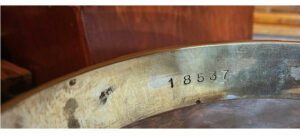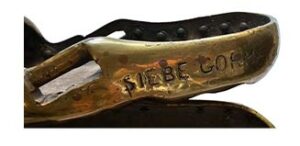Siebe Gorman 12 Bolt Australian Navy
Dive Helmet Ca 1950’s
With a Pair of Bronze Dive Boot Soles

SERIAL NUMBERS:
Bonnet 18537 Breast Plate 18537
Presented is
a 12 bolt, three light Siebe.Gorman Navy dive helmet, dating from around 1954.
Bonnet: 23 lbs Breast Plate: 19 1/2 lbs
Total Weight: 42 1/2 lbs
STAND NOT INCLUDED
In 1840, August Siebe invented the deep-sea diving helmet as we know it today. His helmets are prized worldwide
by collectors and divers, with this helmet being an excellent example.
It appears it was polished and
lacquered some years ago and has a golden patina on
the bonnet and breastplate, with matching serial numbers 18357. The air vents are all intact.
The spit cock handle, front door, and wing nuts turn easily. The helmet is in excellent condition except for a dent (evidence
of use) surrounding the air supply elbow.
 |
 |
Serial No. 18537 on the inner neck rim and rim of the front light.
 |
 |
Bronze Boot Soles: 31 lbs. Length: 13 1/2″ x 5 1/2″
Siebe Gorman manufactured very few styles of Diving boots, and this pair are what are known as Siebe Gorman sand-shoes, which, as the name suggests, are designed for underwater work where the bottom is soft and loose such as sand or silt.
The lead sole of the traditional standard boot is replaced here by an all-bronze sole, which forms most of the shape of the foot, and the leather upper of the sand shoe is much more of a shoe than the traditional boot, giving the diver much more freedom in the foot when trying to walk in the soft.
A nice feature of these ‘shoes’ is that Siebe Gorman stamped their name into the bronze soles, something that you do not find on the Standard Divers boots.
 |
 |
Side Views
 |
 |
Angled SideViews

Back of Siebe Gorman 12 bolt dive helmet
PROVENANCE:
This hat was purchased from someone who bought the helmet and bronze shoe forms in Australia some years ago. It is the Siebe Gorman hat that the Australian Navy used. He was told that it was used in repair or inspection work on the Sydney Bridge.
 |
  |
Interior of bonnet and breast plate – and Siebe Gorman Label
Like all used diving gear, this is being sold for DISPLAY ONLY. It should not be dived without having passed inspection
by a certified Dive shop.
 |
 |
Angled Back Views
MAKER’S BRIEF HISTORY: Augustus Siebe, the German-born founder of the firm that bears his name (1788-1872), is considered
“the father of diving.” Sib’s ‘closed’ diving helmet, first produced in 1840, allowed divers to
dive safely to greater depths. Attached to a rubber suit, it became the ‘Standard Dress’ that revolutionized
diving and made the underwater worker an essential part of salvage operations and civil engineering. Many of the great
building projects of the Victorian era – bridges, tunnels, and lighthouses still in use – could not have been built without
divers.
His design was so successful that it remained in use, essentially unchanged by the Royal Navy until 1989. Born in Saxony in 1788
and trained as a metalworker in Berlin, Siebe served in the Prussian army against Napoleon before emigrating to London in
1816. He moved into 5 Denmark Street, a four-story house dating from the 1680s, in 1830. Located in St Giles-in-the-Fields,
an area which has had a long-standing connection with the metal-working trades, the property served both as his home and his
commercial premises.
